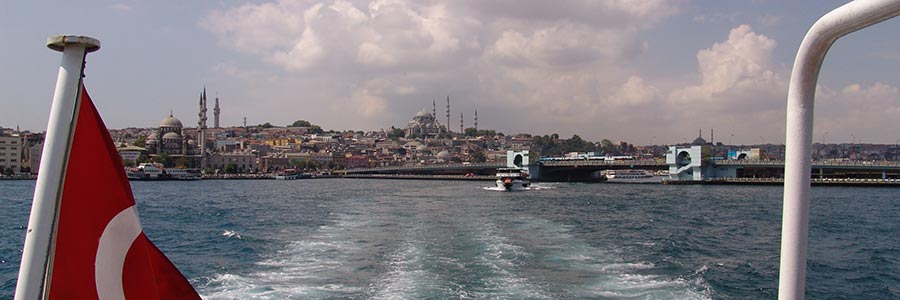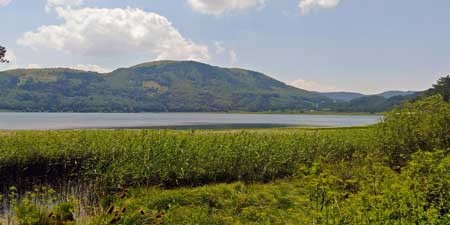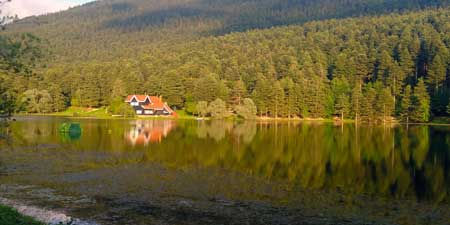Türkiye – broad history and mass tourism today

Since the founding of the republic in 1923 as the successor state to the Ottoman Empire, Turkey has been secular and Kemalist in orientation. The country's founder, Mustafa Kemal Atatürk, initiated a modernization of Turkey through social and legal reforms modelled on various European nation states.
The current President Recep Tayyip Erdoğan has been at the helm of the country since 2003. Since around 2012, he has led the country in an increasingly authoritarian manner. Freedom of expression and freedom of the press in particular are considered to be severely restricted. The currency and debt crisis triggered by its economic policies as well as high inflation have continued since 2018, which makes Turkey quite attractive from a tourist perspective.
The culture of today's Turkey is a fusion of the ancient Turkish nomadic culture of Central Asia and Siberia, the Greco-Roman era, the culture in the Ottoman Empire with its Byzantine, Persian, Arabic, Caucasian, Armenian and Kurdish influences, as well as the strong European direction since the founding of the Republic Ataturk. The cultural centre of the country is the metropolis of Istanbul.
With the political changes, the content of Turkish literature also changed. Early representatives include Fakir Baykurt, Sabahattin Ali, Sait Faik Abasıyanık and Yaşar Kemal, who put ordinary people at the centre of their work. With the turn to describing living conditions, social and political criticism of the state is inevitable. The state reacts with censorship and political violence. Authors like Nâzım Hikmet, Yaşar Kemal and Aziz Nesin spend many years in Turkish prisons because of the persecution of their publications. Kemal therefore referred to the prison as a “school of Turkish literature”.
Turkish cuisine has also influenced Greek and the rest of the Balkan cuisine - including etymology. For example, tzaziki comes from the Turkish cacık, and Ćevapčići comes from kabapcik. Yogurt also comes from Turkish Yoğurt. Doner kebab is made from beef, veal or poultry. In Turkey, but also in other countries, the kebab is also served on a plate.
Abant Lake (Gölü) in the nature park next to Bolu
- Written by Portal Editor
- Category: Black Sea Region
- Hits: 4406

If you pass along the Black Sea coast road near Bolu, you will reach Abant Lake, which is called Abant Gölü in Turkish after approx. 34 kilometres southwest of Bolu.
Bolu and Yedigöller Natural Park
- Written by Portal Editor
- Category: Black Sea Region
- Hits: 7610

Bolu is one of Turkey’s provinces. The Bolu city is one of the best starting points to do an environment excursion. Bolu was constructed as Bithynion in the 2nd century.
International Trabzon Airport - Black Sea
- Written by Portal Editor
- Category: Black Sea Region
- Hits: 7354
Trabzon Airport (IATA: TZX, ICAO: LTCG) is an airport next to Trabzon, a city in the eastern Black Sea region of Turkey. In 2007, it totally served 1,482,760 passengers, 1,397,175 of them were domestic passengers.
Rize and Kaçkar Mountain National Park
- Written by Portal Editor
- Category: Black Sea Region
- Hits: 7567
Rize is a town in the north-east of Turkey on the Black Sea at the foot of the Kackar Mountains, the most eastern and highest part of the Pontian Mountains. The border with Georgia is just 100 kilometres from here.
Trabzon - Çalköy Cave - Akarsu Cave
- Written by Portal Editor
- Category: Black Sea Region
- Hits: 7542
Trabzon (old name was Trapezunt) is a Turkish town at the south coast of Black Sea. In 2000 about 975.137 inhabitants were registered.
At Kaçkar Dağı, the highest peak in the Pontic Mountains
- Written by Portal Editor
- Category: Black Sea Region
- Hits: 7406
In recent years, more and more nature lovers and outdoor enthusiasts have found their way to Turkey.
Giresun – Small beaches between Pontus & Black Sea
- Written by Portal Editor
- Category: Black Sea Region
- Hits: 16568
Giresun, located in north-eastern Turkey on the Black Sea, is the capital and, with almost 90,000 inhabitants, the largest city in the Turkish province of the same name.
Trabzon - Town of Churches and Cloisters
- Written by Portal Editor
- Category: Black Sea Region
- Hits: 18908
The Hagia Sophia Church of Trabzon belongs to the Group of Cloister Churches and had been built at the time of Manuel, one of the most important kings of the Trabzon Empire of Kommenos (from 1238 - 1263).
Samsun - once Greek settlement Amisos
- Written by Portal Editor
- Category: Black Sea Region
- Hits: 22295
Samsun is the largest city of the Black Sea region of Turkey, it is a city with an industry and commerce centre at the same time it possesses a saddening story. For hundreds of years this city has gone through
Amasra - Beautiful Black Sea town!
- Written by Portal Editor
- Category: Black Sea Region
- Hits: 25083
Amasra is one of the most beautiful towns along the Black Sea coast. Poised on a peninsula split by two inlets, the site was first settled in the 12th century B.C. and named after the Persian Princess Amastris.
Sinop - young city with a very old heritage
- Written by Portal Editor
- Category: Black Sea Region
- Hits: 27073
Sinop is a young city with a very old heritage that is losing its charm day by day. It is a city surrounded by beautiful beaches that are located on a long promontory. A suburb of Istanbul, gets into our mind.
Ereğli - Kerberos and the Cehennemağrazı cave
- Written by Portal Editor
- Category: Black Sea Region
- Hits: 24089
Worth mentioning and worth visiting is the area around the city port of Ereğli, west of Zonguldag, even there mainly is heavy industry with iron and steel factories which have settled there.
Myndos Gate to Halicarnassos today Bodrum
- Written by Portal Editor
- Category: Aegean Region
- Hits: 5838
There is hardly any place around Bodrum (formerly called Halicarnassus) in which you will not find at least the foundations of a temple or the remnants of an ancient settlement. If you look at lot of the known names of Greek scientists, artists and scientists, you need to learn, that lot of them lived in today's Turkey.
Izmir Cultural History - Excavations at Tepekule Hill
- Written by Portal Editor
- Category: Aegean Region
- Hits: 4988
Recent excavations at Tepekule Hill near Bayraklı have shown that the Izmir region has been inhabited since around 3000 BC. The city's original name was "Smyrna," meaning "place of the holy mother."
Akköy - Ornithologists boost tourism
- Written by Portal Editor
- Category: Aegean Region
- Hits: 217
The small town of Akköy is located in the heart of the Meander Delta nature reserve on the Dilek Yarimadasi peninsula in the Izmir area, about 5 km from the ancient city of Miletus.
Historical Kemeralti Bazaar of Izmir - the old Smyrna
- Written by Portal Editor
- Category: Aegean Region
- Hits: 39468
As a port town, İzmir has always been strategically important for trade between Anatolia and other Aegean cities. Not surprisingly, the region of Kemeralti on Izmir's shore is a bustling business centre.
Sirince - the cute wine village near Selcuk
- Written by Portal Editor
- Category: Aegean Region
- Hits: 336
Not far from Kusadasi and another highlight of a trip to Turkey could be a visit to the town of Sirince near Selcuk for every tourist.
Hellenistic - Roman city of Ephesus / Efes
- Written by Portal Editor
- Category: Aegean Region
- Hits: 374
Visiting the excavations of the Hellenistic - Roman city of Ephesus between Izmir and Kusadasi, which we visited several times during our travels, is always a special experience.
Izmir - huge City but Pearl of Aegean Sea
- Written by Portal Editor
- Category: Aegean Region
- Hits: 20130
A very big town with the welcoming atmosphere of a village. We stayed out of town in a suburb called Buca in the apartment of our Turkish friend's mother. Everybody was very friendly and we experienced the genuine Turkish way of life, with mealtimes especially being a real family occasion.
Museums in Izmir - The Archaeological Museum
- Written by Portal Editor
- Category: Aegean Region
- Hits: 403
The archaeological museum is located in the cultural park of the city of Izmir, where finds from the western Anatolian, Ionian cities and the surrounding area can be seen, even if you prefer to visit the original sites, a worthwhile alternative.